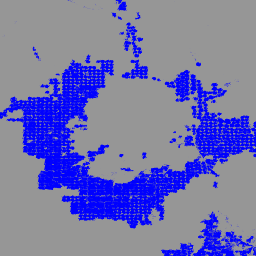
- Dostępność zbioru danych
- 1986-01-01T00:00:00Z–2024-01-01T00:00:00Z
- Dostawca zbioru danych
- University of Montana / Montana Climate Office
- Tagi
Opis
IrrMapper to coroczna klasyfikacja stanu nawadniania w 11 zachodnich stanach USA przeprowadzana w skali Landsat (czyli 30 m) przy użyciu algorytmu Random Forest w latach 1986–obecnie.
W artykule o IrrMapperze opisano klasyfikację 4 rodzajów obszarów (nawadniane, suche, nieuprawiane i podmokłe), ale zbiór danych został przekształcony w klasyfikację binarną, która obejmuje obszary nawadniane i nienawadniane.
„Nawadniane” oznacza wykrycie nawadniania w ciągu roku. Model lasu losowego IrrMapper został wytrenowany na podstawie obszernej geoprzestrzennej bazy danych pokrycia terenu z każdej z 4 klas obszarów nawadnianych i nienawadnianych, w tym ponad 50 tys. zweryfikowanych przez człowieka pól nawadnianych, 38 tys. pól suchych i ponad 500 tys. km² nieużytków.
W przypadku wersji 1.2 znacznie rozszerzono oryginalne dane treningowe, utworzono model RF dla każdego stanu oraz przeprowadzono dokładniejszą analizę walidacji i niepewności. Zapoznaj się z dodatkiem do naszego artykułu na temat wpływu nawadniania na przepływ wody w strumieniach.
Pasma
Rozmiar piksela
30 metrów
Pasma
| Nazwa | Rozmiar piksela | Opis |
|---|---|---|
classification |
metry | Piksele nawadniane mają wartość 1, a pozostałe piksele są zamaskowane. |
Warunki korzystania z usługi
Warunki korzystania z usługi
Cytaty
Ketchum, D.; Jencso, K.; Maneta, M.P.; Melton, F.; Jones, M.O.; Huntington, J. IrrMapper: podejście oparte na uczeniu maszynowym do mapowania w wysokiej rozdzielczości nawadnianych upraw w zachodnich Stanach Zjednoczonych, Remote Sens. 2020, 12, 2328. doi:10.3390/rs12142328
Ketchum, D., Hoylman, Z.H., Huntington, J. i in. Irrigation intensification impacts sustainability of streamflow in the Western United States. Commun Earth Environ 4, 479 (2023). doi:10.1038/s43247-023-01152-2
Odkrywanie za pomocą Earth Engine
Edytor kodu (JavaScript)
var dataset = ee.ImageCollection('UMT/Climate/IrrMapper_RF/v1_2'); var irr = dataset.filterDate('2023-01-01', '2023-12-31').mosaic(); var visualization = { min: 0.0, max: 1.0, palette: ['blue'] }; Map.addLayer(irr, visualization, 'IrrMapper 2023'); Map.setCenter(-112.516, 45.262, 10);
